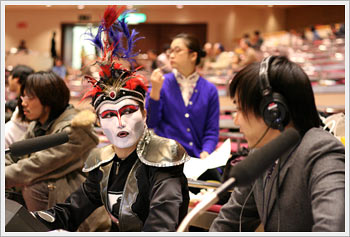This is Demon Kokugure, a performer and artist, and serious sumo fan. Here he is doing commentary for NHK’s sumo broadcast (he’s doing a full 5 hours for them, very unusual). Don’t judge this book by the cover, this guy knows his sumo, frontwards and back. I’m looking forward to being able to hear his insight when I watch the DVD recording tonight. (I’ll upload a better image tonight as well.)
The arbitrary difficulty of language
A friend recently wrote the following on his blog about his son (1 year, 4 months old):
I have to work harder at teaching him [English] words, but I get the feeling he will speak more Japanese first, because there are so many easy two-syllable words for him to pronounce easily in Japanese, and most English words that I say to him are longer and harder to pronounce in comparison.
To which I responded, in a comment (I’m posting more or less verbatim, so this is a bit rough-hewn):
just my two yen of course but I wouldn’t fall for the “japanese is easier to pronouce than english” trap too quickly….i heard similar when my little one was taking his first verbal steps….just remember, your little one isn’t saying anything is difficult, his parents (and other well-meaning folk) are! for him, the concept of “difficulty” doesn’t exist.
the fact of the matter is, is that kids in an English environment, or kids in a Swahili environment (okay, i know nothing about Swahili but you get the idea), learn perfectly well how to start repeating sounds, regardless of whether the word is “difficult” to pronouce. the very concept of “difficulty” is arbitrary and tends to reflect the speaker’s point of view, not an objective fact. I mean, for most of us native English speakers, French is at the same time an incomparably beautiful and exceeding difficult to pronouce correctly language…yet the very fact that there are millions of people who can speak the language beautifully gives the lie to the idea that the language is difficult at all, for those born into that language.
I have found that if you are serious about your child learning your own language, as I trust you are, you have to view that development within your language, not via the pov of the other language. Granted, being that English is the minority language, and that the child is surrounded by Japanese almost every moment of his life, it IS an uphill battle, but that doesn’t mean you should be raising any white flags. In actual fact, there is little difference between “atta” and “there it is”, or “baba” and “grandma”, but even to acknowledge that is to worry too much about it. just teach him what you want. hell, I’d start him on “supercalifragilisticexpialidocious” right now!
(of course the same applies to your [Japanese] wife wanting him to speak Japanese as a native, which means we need to try not to correct his pronunciation when he says “makudonarudo” [McDonald’s in Japanese])
I’m curious what others think, especially those raising (or trying to raise) a child bilingually. I’m no expert of course, and Kaika still has a long way to go before we can hope to proclaim him bilingual, but I guess I’m natually suspicious of this idea that Japanese, which doesn’t have a lot of words longer than 2 syllables (at least not any words a toddler needs to know!), not to mention that it does have a lot of onomatopoeic words that can at times be mistaken for “baby talk”, automatically makes it easier to learn.
On the other hand, I suppose one could make the argument that the child really isn’t aware he’s repeating “words” but rather is just sounding out sounds, sounds he’s only vaguely connecting with meaning. In which case, I guess the easier to replicate sounds (or syllables) would get the advantage. I don’t know.
Well, you can see I’m no linguist, but if you have an opinion or your own experiences to share, please leave a comment.
Ise Shrine
.flickr-photo { border: solid 2px #000000; }
.flickr-yourcomment { }
.flickr-frame { text-align: left; padding: 3px; }
.flickr-caption { font-size: 0.8em; margin-top: 0px; }
Given that part of the purpose of this trip was to get away from all the various goings on around New Years time, it’s highly ironic — or just stupid — that I decided on the spur of the moment to visit Ise Shrine, which just so happens to be the holiest Shinto place in Japan. “The ‘vatican’ of Shintoism,” as it has been put. I almost got to where everyone was heading, but the steady flow of foot traffic soon became a solid wall of standing still worshippers, and I didn’t like my prospects of getting there and back in a reasonable time, and so I turned around. And less pragmatically speaking, I started to feel somewhat guilty of my agnosticism. A perverse notion in Japan perhaps, considering that if you asked the legions who were there today, “Are you religious?” the overwhelming answer would be “No!” But having experienced more or less the same thing yesterday at Himeji, seemingly the only person not offering a prayer at the shrine, I knew it would be awkward.


